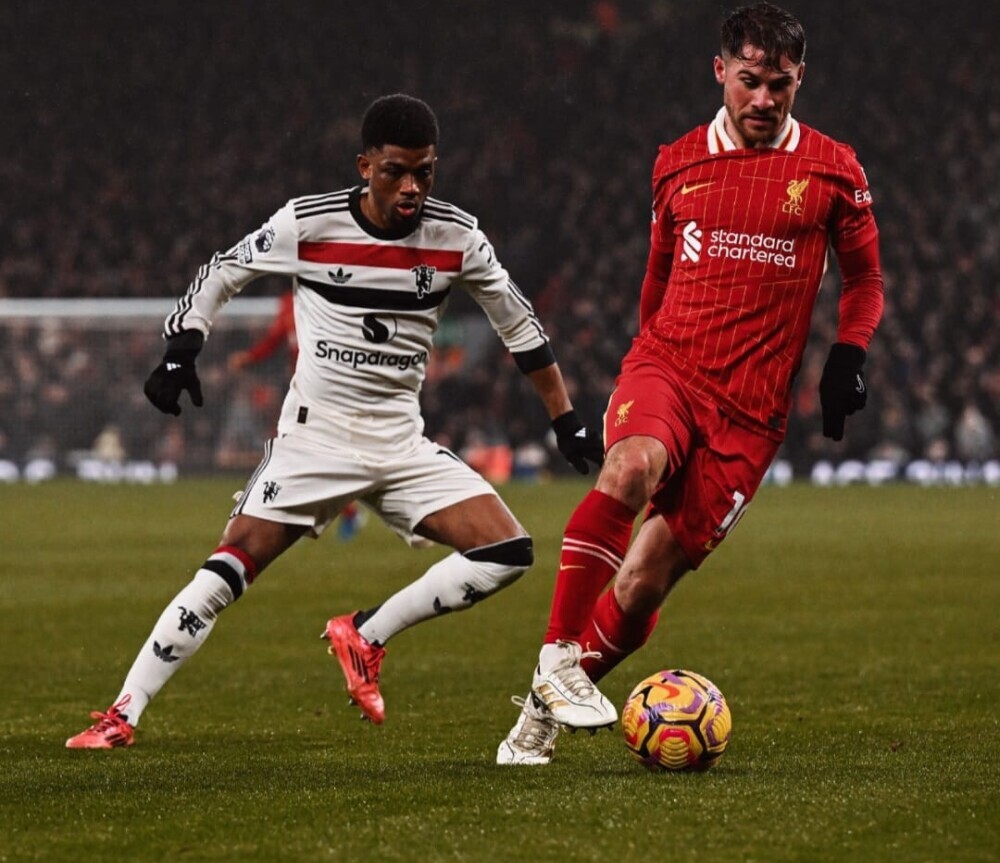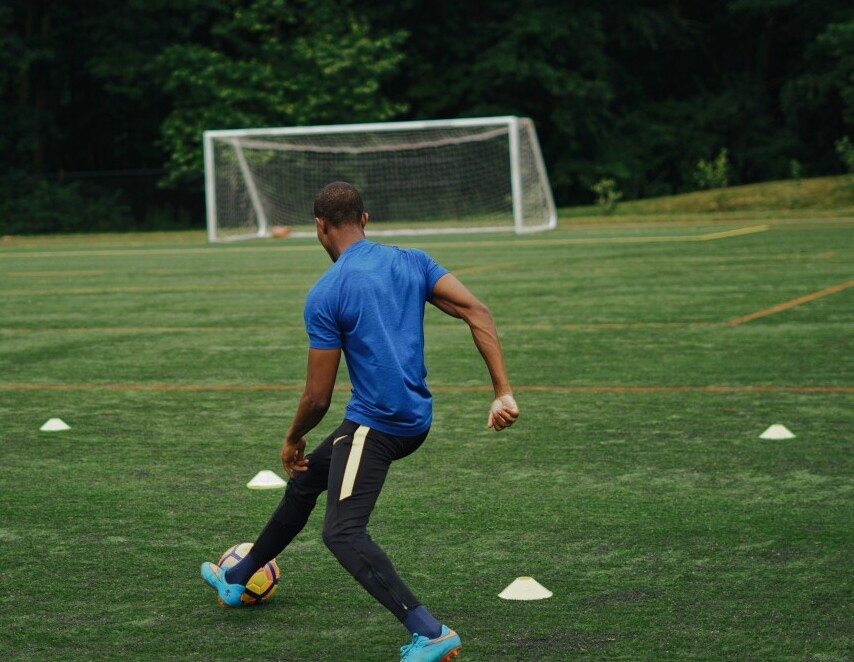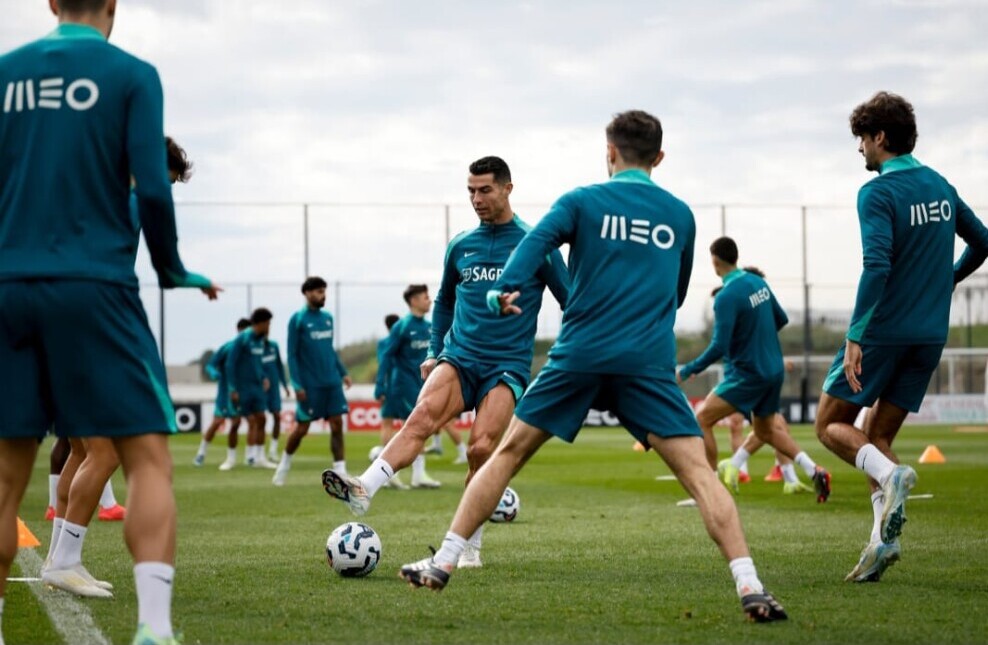Even the biggest soccer field can feel small when there’s a defender on your case — that’s why we work on dribbling in tight spaces.
As a soccer player, one of the first skills you learn is how to dribble a ball, but there’s so much more to soccer dribbling than meets the eye.
While it may seem like one of the most basic soccer skills, dribbling can take many forms, whether it’s breaking away from a defender with big touches to attack a goal, or using different parts of the foot to dribble depending on the situation.
Dribbling under pressure is all about handling limited time and space. Limited time means a defender is quickly narrowing down on you, whereas limited space usually means the defender’s right on top of you.
 (Picture courtesy of Liverpool WhatsApp Group)
(Picture courtesy of Liverpool WhatsApp Group)
This kind of dribbling isn’t just useful; it’s essential. It helps you keep possession and create opportunities when the field gets crowded.
Practicing dribbling in tight spaces isn’t just about keeping control of the ball; it also boosts your confidence when you’re surrounded.
Knowing that you can handle pressure without losing the ball gives you an edge. You’ll feel more in control, and trust me, that can change the way you play.
It sharpens your quick-thinking abilities too. During a game, decisions often need to be made in a split second.
With good dribbling skills, you can react faster and more effectively. You can either shield the ball while waiting for support or maneuver through defenders to create a scoring opportunity.
The benefits?
Mastering these dribbling skills can make you a more versatile player. Defenders won’t be able to predict your moves easily, giving you a tactical advantage.
Plus, by keeping the ball close and making sharp moves, you can navigate through tight defenses more efficiently.
Techniques for Shielding the Ball from Defenders
Shielding the ball is a cornerstone of dribbling in tight spaces. When a defender’s hot on your trail, ball control is everything.
Shielding involves using the sole of your foot to maneuver the ball, making it nearly impossible for the opponent to take it from you.
Imagine your foot as a barrier between the ball and the defender — that’s shielding in a nutshell.
So, how do you do it?
First off, keep the ball on the foot farthest from the defender. This way, you’re constantly putting your body between the ball and the opponent.
It’s almost like you’re playing keep-away. Use your arm closest to the defender as an extra shield. Yes, it feels a bit awkward at first, but with practice, it becomes second nature.
Foot placement is crucial. The ball should be close to your foot, and you’ll be using the sole to move it around.
Small touches make all the difference. With the ball close, it’s easier to control and shield from pokes and tackles.
 (Picture courtesy of Man United WhatsApp Group)
(Picture courtesy of Man United WhatsApp Group)
Meanwhile, keeping your head up is vital, letting you scan the field for a better option, whether that’s a pass or a clever turn to shake off the defender.
Let’s talk scenarios when shielding really shines.
When you’re cornered near the sideline, or when you’re waiting for teammates to catch up during a counterattack, shielding helps you buy crucial time.
It allows you to maintain possession and make smarter plays under pressure.
Enhancing shielding skills over time takes dedication. Start slow and focus on technique.
Use drills where you practice keeping the ball close while a teammate applies light pressure. Gradually, increase the intensity to simulate in-game situations.
Consistent practice can make shielding second nature, giving you that extra layer of control and confidence on the field.
Navigating Through Tight Defenses: Movement and Spacing
When you’re up against a defender and there’s no immediate teammate to pass to, it’s all about finding the best way out.
Dribbling past a defender in tight spaces asks for quick thinking and sharp skills.
The ‘hula hoop’ rule is a good starting point. Keeping the ball within hula hoop distance makes it harder for defenders to snatch it away.
Imagine a hula hoop surrounding you and don’t let the ball get too far outside it. It may sound simple, but try it in a game with a defender charging at you, and you’ll see how effective it is.
Maintaining vision is crucial. Stay aware of your surroundings by keeping your head up.
This helps you not just dodge defenders but identify open space and opportunities for advancing the ball.
Constantly scanning the field gives you a split-second advantage, which is all you need to make a killer play.
Speed variations can make or break a dribble through a tight defense.
Small, controlled touches help you maneuver around defenders, while bigger, explosive touches can help you zoom past them when you find an opening. Think of it as a dance: small steps to get the rhythm, then a larger, quicker move to break free.
But talking about it is one thing.
Practicing is another.
A drill I swear by is Cones Island. Set up a 20×20 grid with an island of cones in the center.
Players dribble diagonally through the cones from corner to corner. Start with two players at a time for focus, then up the ante with four at once to really get that head-up awareness and spatial coordination going.
Here’s what to concentrate on: small touches, using the pinky toe, and head up after every touch.
Once they’re comfortable, make it a race to add some competitive fun. Trust me, this drill tightens up dribbling skills like nothing else.
Advanced Dribbling Moves to Outsmart Defenders
Alright, so you’ve got shielding and basic navigation down, but what about bringing some flair to your game?
Advanced dribbling moves can help you completely bamboozle defenders, making it easier to break through tight defenses. Let’s talk tactics.
Feints and fakes are your bread and butter here. Simple but effective, a well-executed fake can give you that split-second you need to change direction and leave a defender in the dust.
The step-over is a classic.
Step over the ball with one foot, make it look like you’re going one way, then use the outside of the other foot to go the other direction.
Then there’s the Cruyff turn.
Cut the ball behind your standing leg, turning sharply in the opposite direction. Elite and subtle, this move keeps the ball close and the defender guessing. It’s a game-changer when executed well.
Don’t underestimate the pullback. It might look simple, but pulling the ball back and changing direction can be extremely effective, especially if the defender’s momentum is going forward.
It’s about timing and keeping control of the ball. A good pullback can create space and give you the breathing room to plan your next move.
Speaking of creativity, sometimes the best move is one you come up with on the spot.
Be unpredictable. Mix and match different dribbling skills — maybe start with a fake, then pull back, or weave in a quick Cruyff turn. Keeping defenders guessing makes you harder to defend.
Want to polish these moves? The Circuit Dribbling drill sets up three channels with different challenges.
Dribble through cones in one, zig-zag in another, and then cut around flags before shooting on goal. Each channel works on different aspects of dribbling, from control to speed to precision.
Keep an eye on these coaching points: quick feet, ball close to the foot, and toes pointing down.
With time and practice, these advanced moves become part of your natural game, turning you into that elusive player defenders hate to face.
Take away
Soccer dribbling drills in small spaces are essential for players looking to improve their ball control, agility, and decision-making.
By mastering shielding, navigation, and advanced dribbling moves, you’ll become a more dynamic and effective player on the field.
Don’t forget to stay focused, keep practicing, and always be looking for ways to improve your game.
With the right training and mindset, you’ll be unstoppable on the soccer field.
Please leave your questions, opinion or experience in the comment section below and I promise to get back to you.
Happy soccer season.!!!!!!!!!!!!!!!
Must-Have Gear for Small-Space Dribbling Practice
Want to level up your training? Here are some affordable Amazon tools to set up your own mini training ground:
- 🟢 Agility Cones – Perfect for drills like zig-zags and Cones Island.
- ⚽ Adidas MLS Club Soccer Ball – A great ball for both beginners and advanced players.
- 🟡 Senda Street Freestyle Ball – Designed for tight control on hard surfaces.
- 📘 Soccer Drills: A Step-by-Step Guide – A tactical manual for advanced skill development.
Here’s a little transparency: Our website contains Amazon affiliate links. This means if you click and make a purchase, we may receive a small commission. Don’t worry, there’s no extra cost to you. It’s a simple way you can support our mission to bring you quality content.”



Great post, Raymond! My 13-year-old son plays soccer at school, and while he loves the game, he struggles a bit with dribbling, especially in tight spaces. Your breakdown of shielding and navigating through defenders really stood out to me—I think these techniques could help him build confidence when he’s under pressure.
I especially appreciate the ‘hula hoop’ rule and the Cones Island drill. They seem like great ways to improve ball control in a fun and structured way. We’ll definitely try them out at home!
Thanks for sharing such valuable tips. Looking forward to more of your insights!
Hi Alice,
Thank you so much for your thoughtful comment!
I’m really glad the post resonated with you—and it’s awesome to hear about your son’s passion for soccer.
Dribbling under pressure can definitely be tricky at first, but with practice (and a few fun drills like the Hula Hoop Rule and Cones Island), it gets easier and a lot more enjoyable!
I’m sure with a little consistency and encouragement, he’ll gain more confidence with his ball control in no time.
Feel free to check back in and let me know how he’s progressing—I’d love to hear about it!
Thanks again for your support, and I’ll definitely be sharing more drills and tips soon!
Best wishes,
Raymond
This was such an insightful and practical guide on dribbling drills! I loved how you broke down each technique with clear instructions, making it easy for both beginners and advanced players to improve their skills. The emphasis on control and footwork was especially useful, as those are key to mastering dribbling under pressure. Have you found any specific drill that works best for improving dribbling speed while maintaining accuracy?
Hi Kavitha,
Thank you so much for your kind words—I’m really glad you found the guide helpful!
You’re absolutely right: control and footwork form the foundation of confident dribbling, especially in tight spaces where quick thinking and precision are key.
As for improving dribbling speed while maintaining accuracy, one drill I’ve found particularly effective is the “Cone Weave with Speed Bursts.” It starts with controlled dribbling through tightly spaced cones, then includes short 5–10 yard sprints immediately after each run.
This helps simulate the sudden acceleration needed in games while keeping the player focused on tight control.
Another great one is the “Box Drill with Timed Intervals”—set up a small square using cones and have the player complete as many clean touches as possible within a time limit. It pushes both speed and accuracy under a bit of pressure.
Thanks again for your comment!
If you try either drill or already have one that works well for you, I’d love to hear about it!
Raymond